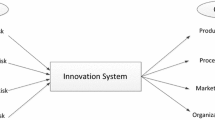Abstract
With the rapid development of IT, technology innovation has attracted increasing attentions from governments, enterprises and researchers. It is notable that the failure rate of technology innovation is high and the risk cannot be ignored. Risk identification is a critical step of risk management and to identify risk accurately and effectively is important for technology innovation organizations. However, the extant risk identification approaches cannot be directly applied, due to the characteristics of technology innovation risk such as uncertainty and fuzziness. In this paper we introduce matter-element model, which is developed from extension theory, and can be employed to support the characteristics of technology innovation risk. On the basis of the traditional meta-model, this paper attempts to improve the schema, through constructing indicator system of technology innovation risk. We present a method of determining the weights of indicators based on minimum deviation, which integrates the AHP weight and entropy weight. Through the calculating process and sensitivity analysis, the risk factors of technology innovation with different features can be identified, and technology innovation organizations can formulate and perform targeted strategies toward different risk factors. Finally, based on an instance, we discuss the effectiveness of our method and draw the conclusions.












Similar content being viewed by others
References
Bi K, Huang P, Ye H (2015) Risk identification, evaluation and response of low-carbon technological innovation under the global value chain: a case of the Chinese manufacturing industry. Technol Forecast Soc Change 100:238–248
Flanagan R (1993) Risk management and constructions. Blackwell Scientific, London
Ghosh D, Guha R (2010) Use of genetic algorithm and neural network approaches for risk factor selection: a case study of West Nile virus dynamics in an urban environment. Comput Environ Urban Syst 34:189–203
He Y, Dai A, Zhu J, He H, Li F (2011) Risk assessment of urban network planning in china based on the matter-element model and extension analysis. Electr Power Energy Syst 33:775–782
Keizer JA, Vos JP, Halman JIM (2005) Risks in new product development: devising a reference tool. R&D Manag 35(3):297–309
Kelly L, Smith L (2009) Bayesian inference in probabilistic risk assessment–the current state of the art. Reliab Eng Syst Saf 94(2):628–643
Lang TM, Lin SH, Vy TNT (2012) Mediate effect of technology innovation capabilities investment capability and firm performance in Vietnam. Proc Soc Behav Sci 40:817–829
Lindhe A, Rosen L, Norberg T, Bergstedt O (2009) Fault tree analysis for integrated and probabilistic risk analysis of drinking water systems. Water Res 43:1641–1653
Oehmen J, Olechowski A, Kenley CR, Ben-Daya M (2014) Analysis of the effect of risk management practices on the performance of new product development programs. Technovation 34:441–453
Pan G, Xu Y, Yu Z, Song S, Zhang Y (2015) Analysis of river health variation under the background of urbanization based on entropy weight and matter-element model: a case study in Huzhou City in the Yangtze River Delta, China. Environ Res 139:31–35
Wang R, Zhu X, Li F (2012) Supply chain risks evaluation model in fuzzy environment. J Syst Manag Sci 2(4):37–43
Wang C, Wu A, Lu H, Bao T, Liu X (2015) Predicting rockburst tendency based on fuzzy matter–element model. Int J Rock Mech Min Sci 75:224–232
Wu D, Olson DL (2010) Enterprise risk management: coping with model risk in a large bank. J Oper Res Soc 61:179–190
Wu J, Wu Z (2014) Integrated risk management and product innovation in China: the moderating role of board of directors. Technovation 34:466–476
Xiao Q (2016) Technology Innovation Risk Identification Based on Sequential CBR. In: IEEE international conference on logistics, informatics and service sciences, pp 1015–1018
Zhang X, Yue J (2017) Measurement model and its application of enterprise innovation capability based on matter element extension theory. Proc Eng 174:275–280
Zhang X, Yang Y, Su J (2015) Risk identification and evaluation of customer collaboration in product development. J Ind Eng Manag 8(3):928–942
Acknowledgements
This work is supported by the National Natural Science Foundation of China (NSFC, Grant No. 71361011).
Author information
Authors and Affiliations
Corresponding author
Rights and permissions
About this article
Cite this article
Xiao, Q. A matter-element method for risk identification of technology innovation. Int J Syst Assur Eng Manag 9, 716–728 (2018). https://doi.org/10.1007/s13198-017-0667-8
Received:
Revised:
Published:
Issue Date:
DOI: https://doi.org/10.1007/s13198-017-0667-8




